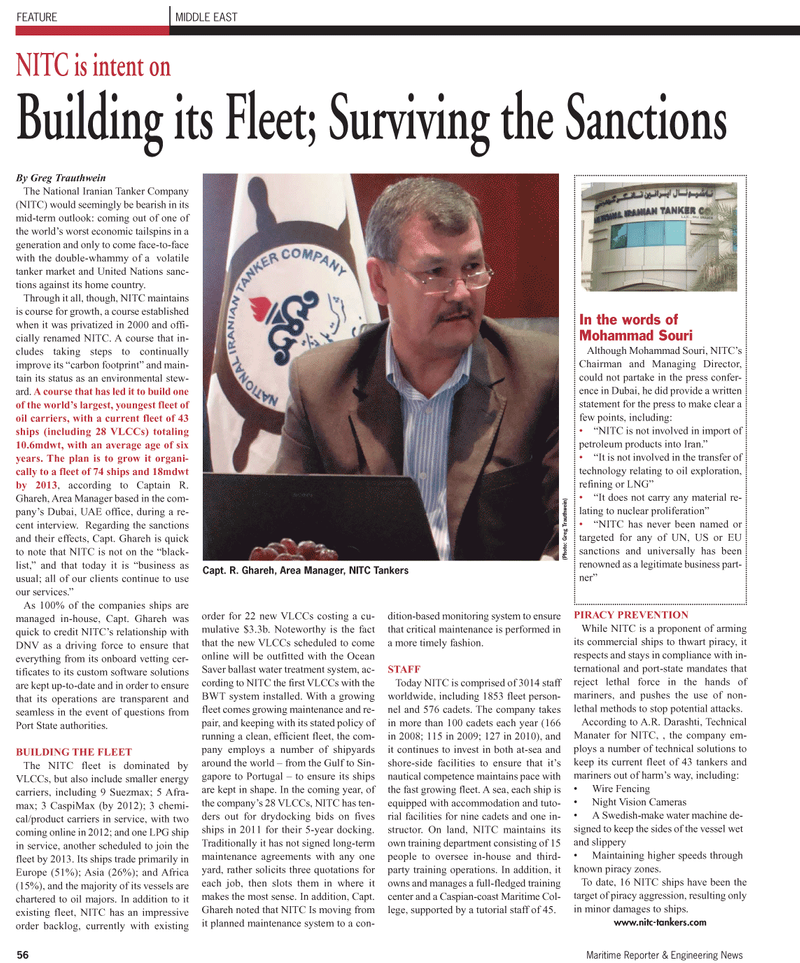
Page 56: of Maritime Reporter Magazine (March 2011)
Ship Repair & Conversion
Read this page in Pdf, Flash or Html5 edition of March 2011 Maritime Reporter Magazine
56 Maritime Reporter & Engineering News
By Greg Trauthwein
The National Iranian Tanker Company (NITC) would seemingly be bearish in its mid-term outlook: coming out of one of the world’s worst economic tailspins in a generation and only to come face-to-face with the double-whammy of a volatile tanker market and United Nations sanc- tions against its home country.
Through it all, though, NITC maintains is course for growth, a course established when it was privatized in 2000 and offi- cially renamed NITC. A course that in- cludes taking steps to continually improve its “carbon footprint” and main- tain its status as an environmental stew- ard. A course that has led it to build one of the world’s largest, youngest fleet of oil carriers, with a current fleet of 43 ships (including 28 VLCCs) totaling 10.6mdwt, with an average age of six years. The plan is to grow it organi- cally to a fleet of 74 ships and 18mdwt by 2013, according to Captain R.
Ghareh, Area Manager based in the com- pany’s Dubai, UAE office, during a re- cent interview. Regarding the sanctions and their effects, Capt. Ghareh is quick to note that NITC is not on the “black- list,” and that today it is “business as usual; all of our clients continue to use our services.”
As 100% of the companies ships are managed in-house, Capt. Ghareh was quick to credit NITC’s relationship with
DNV as a driving force to ensure that everything from its onboard vetting cer- tificates to its custom software solutions are kept up-to-date and in order to ensure that its operations are transparent and seamless in the event of questions from
Port State authorities.
BUILDING THE FLEET
The NITC fleet is dominated by
VLCCs, but also include smaller energy carriers, including 9 Suezmax; 5 Afra- max; 3 CaspiMax (by 2012); 3 chemi- cal/product carriers in service, with two coming online in 2012; and one LPG ship in service, another scheduled to join the fleet by 2013. Its ships trade primarily in
Europe (51%); Asia (26%); and Africa (15%), and the majority of its vessels are chartered to oil majors. In addition to it existing fleet, NITC has an impressive order backlog, currently with existing order for 22 new VLCCs costing a cu- mulative $3.3b. Noteworthy is the fact that the new VLCCs scheduled to come online will be outfitted with the Ocean
Saver ballast water treatment system, ac- cording to NITC the first VLCCs with the
BWT system installed. With a growing fleet comes growing maintenance and re- pair, and keeping with its stated policy of running a clean, efficient fleet, the com- pany employs a number of shipyards around the world – from the Gulf to Sin- gapore to Portugal – to ensure its ships are kept in shape. In the coming year, of the company’s 28 VLCCs, NITC has ten- ders out for drydocking bids on fives ships in 2011 for their 5-year docking.
Traditionally it has not signed long-term maintenance agreements with any one yard, rather solicits three quotations for each job, then slots them in where it makes the most sense. In addition, Capt.
Ghareh noted that NITC Is moving from it planned maintenance system to a con- dition-based monitoring system to ensure that critical maintenance is performed in a more timely fashion.
STAFF
Today NITC is comprised of 3014 staff worldwide, including 1853 fleet person- nel and 576 cadets. The company takes in more than 100 cadets each year (166 in 2008; 115 in 2009; 127 in 2010), and it continues to invest in both at-sea and shore-side facilities to ensure that it’s nautical competence maintains pace with the fast growing fleet. A sea, each ship is equipped with accommodation and tuto- rial facilities for nine cadets and one in- structor. On land, NITC maintains its own training department consisting of 15 people to oversee in-house and third- party training operations. In addition, it owns and manages a full-fledged training center and a Caspian-coast Maritime Col- lege, supported by a tutorial staff of 45.
PIRACY PREVENTION
While NITC is a proponent of arming its commercial ships to thwart piracy, it respects and stays in compliance with in- ternational and port-state mandates that reject lethal force in the hands of mariners, and pushes the use of non- lethal methods to stop potential attacks.
According to A.R. Darashti, Technical
Manater for NITC, , the company em- ploys a number of technical solutions to keep its current fleet of 43 tankers and mariners out of harm’s way, including: • Wire Fencing • Night Vision Cameras • A Swedish-make water machine de- signed to keep the sides of the vessel wet and slippery • Maintaining higher speeds through known piracy zones.
To date, 16 NITC ships have been the target of piracy aggression, resulting only in minor damages to ships. www.nitc-tankers.com
NITC is intent on
Building its Fleet; Surviving the Sanctions (Photo: Gr eg T rauthwein)
FEATURE MIDDLE EAST
Capt. R. Ghareh, Area Manager, NITC Tankers
In the words of
Mohammad Souri
Although Mohammad Souri, NITC’s
Chairman and Managing Director, could not partake in the press confer- ence in Dubai, he did provide a written statement for the press to make clear a few points, including: • “NITC is not involved in import of petroleum products into Iran.” • “It is not involved in the transfer of technology relating to oil exploration, refining or LNG” • “It does not carry any material re- lating to nuclear proliferation” • “NITC has never been named or targeted for any of UN, US or EU sanctions and universally has been renowned as a legitimate business part- ner”

 55
55

 57
57
